In this October97 opening at M.I.T., I resituated my work from the past
20 years, in the disturbing and disorienting venue of ``cyberfashion''.
The underlying meaning of the exhibit has been lost to many (and made light
of in recent years, with the explosion of "cyberfashion"), but that will
need to be left for a future exhibit.
Some of Steve Mann's WearComp/WearCam inventions from the past 20 years,
were presented on mannequeins throughout the gallery:
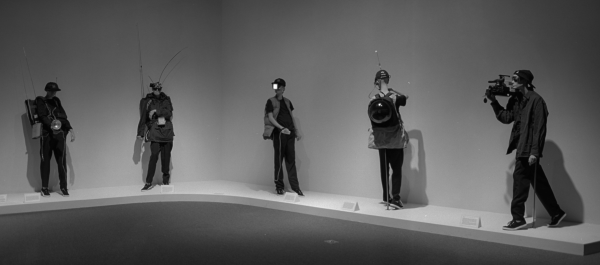
ShootingBack, on exhibit at List Visual Arts Center, Oct9 - Dec28, 1997
A mid 1980s version of Mann's "WearComp" invention:
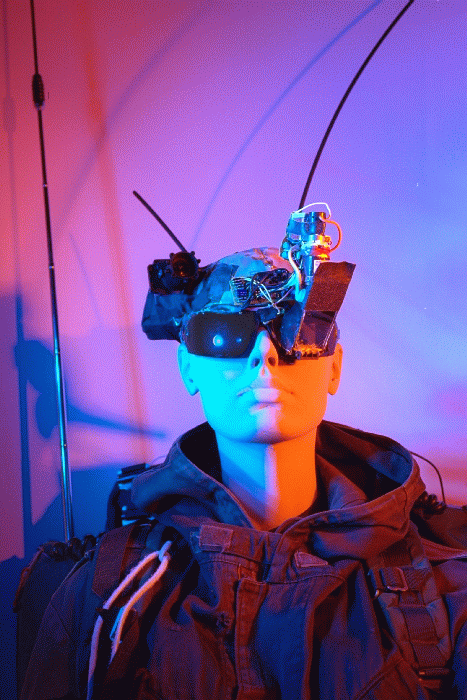
A 1970s version of the "WearComp" apparatus. Mann's
early photographic inventions bear many similarities to current-day
WearComp systems:
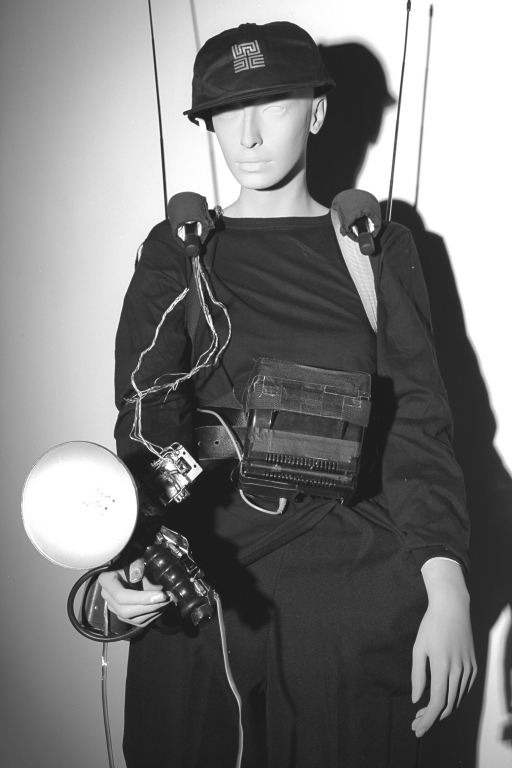
Covert video recording system concealed in eyeglasses was used together
with an outdated hand-held camcorder, in the production of the
meta-documentary (documentary about making a documentary about
video surveillance)
ShootingBack.
The camcorder served merely as a prop,
while recording was actually done through the eyeglass-based system,
which captured the process of making a documentary video, and allowed
the remote viewer on the WWW to experience what it was like to look
through the viewfinder of a camcorder and observe the reactions
to the camcorder
of security guards and other representatives of organizations using
video surveillance.

Various embodiments of "maybe camera",
and "probably camera"
explore issues of surveillance in society.
This "ShootingBackPack" re-situates the ubiquitous but
mysterious
ceiling domes of wine-dark
opacity  in a disturbing and disorienting
fashion by placing them upon the backs of otherwise
vanquished (surveilled) individuals as instruments of personal
empowerment and personal safety.
in a disturbing and disorienting
fashion by placing them upon the backs of otherwise
vanquished (surveilled) individuals as instruments of personal
empowerment and personal safety.
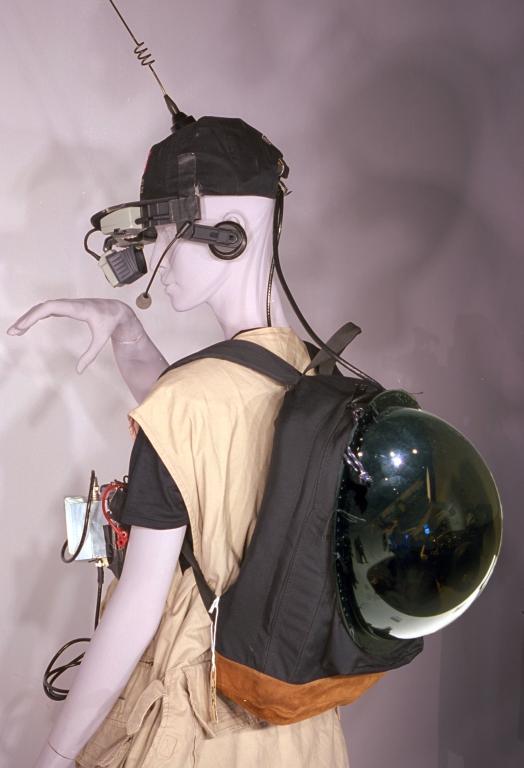
These and other pieces from
the exhibit re-situate the everyday familiar objects that are tools of
control and monitoring, such as the computer, in a disturbing
and disorienting fashion, within the prosthetic territory
of the otherwise vanquished individual.
This establishes a form of
personal empowerment in order to challenge society's pre-concieved
notions of the individual versus the organization.
The pieces are examples of "reflectionism",
in particular, within the context
of holding a mirror up to surveillance in society.
If you're in the MIT area, you might want to look at my exhibit at the
List Visual Arts Center (LVAC), located on the first floor of building E15,
which also houses the Media Lab, located at 20 Ames Street, Cambridge, MA.
I have, on display, set up on mannequins,
some embodiments of my
WearComp/WearCam
invention
selected from the 100 or so units I've built over the last 20 years.
The particular
units that I have selected for the show deal with issues of surveillance
in society (re-situating the video camera in a disturbing and disorienting
fashion in order to challenge our pre-conceived notion of surveillance in
society).
The exhibit is a retrospective of past performances, such
as ShootingBack,
the tools of which are situated on mannequins
along with some other artefacts, so that they are re-created
as interactive video sculptures.
One of the pieces on display in the List Center
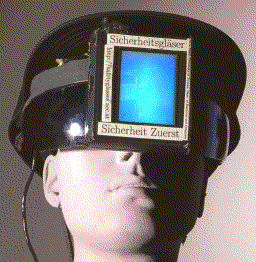
was also used in
the week long performance piece I did at
Ars Electronica, along
with my invited plenary lecture in the Ars Electronica Symposium.
The performance was called "Sicherheitsglaeser", and some images
can be revisited at:
http://n1nlf-1.eecg.toronto.edu/sicherheitsglaeser/
Shortly afterwards, the rig traveled (on my body) back to the United
States, to ISEA:
http://n1nlf-1.eecg.toronto.edu/isea97/
Performance piece. The performance took place October 7th, 1997,
in which I wore a full sphere dome completely surrounding my head.
The dome was a full 4 pi steredians solid angle (a full one spat,
if you prefer the British unit of solid angle) except for a
neck cutout at the bottom of the sphere. Inside the 12 inch diameter
transparent but dark spherical dome, I wore my eyeglasses transmitting
live video to the Internet. Here's what the sphere looks like
(you can see the neck hole cut out at the bottom, which is facing away
but visible through the transparent but dark top):
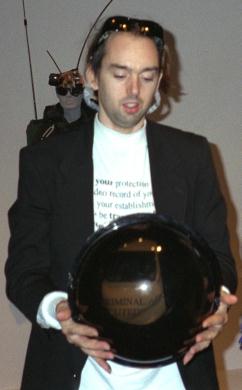
The fullsphere head dome comprises two hemispheres joined together,
the neck hole being cut through the bottom hemisphere.
Prof. Steve Mann
University of Toronto
Department of Electrical Engineering, Room S.F. 2001,
10 King's College Road; Toronto, Ontario, Canada; M5S 3G4
Tel. 416.946-3387
Fax. 416.971-2326
http://www.eecg.toronto.edu/~mann
Thanks to Jennifer Riddell, Katherine Kline, and Jonathan Roll
for extensive help in setting up the exhibit of my rigs.
Thanks also to Julia Scher, Krzysztof Wodiczko, and many others
who made valuable suggestions along the way.
Work presented in this exhibit was funded, in part, by the
Council for the Arts at MIT.
See
http://wearcam.org/pleasewait.html
for Please Wait: A parody of the time thieves
(Excerpt from Prof. Mann's Keynote Address at the Virtual Reality Conference
in Rio de Janiero, June 1-6, 1998), Time Crime
Similar exhibit at the Stedelijk
Museum (actually this is a traveling
exhibit that goes to various museums and galleries around the world).
See theory of darkness
(an April Fool's research paper)
for a humorous look at the mysterious ceiling domes of wine-dark
opacity called "dark fixtures".
Other art-related
research papers





 in a disturbing and disorienting
fashion by placing them upon the backs of otherwise
vanquished (surveilled) individuals as instruments of personal
empowerment and personal safety.
in a disturbing and disorienting
fashion by placing them upon the backs of otherwise
vanquished (surveilled) individuals as instruments of personal
empowerment and personal safety.

